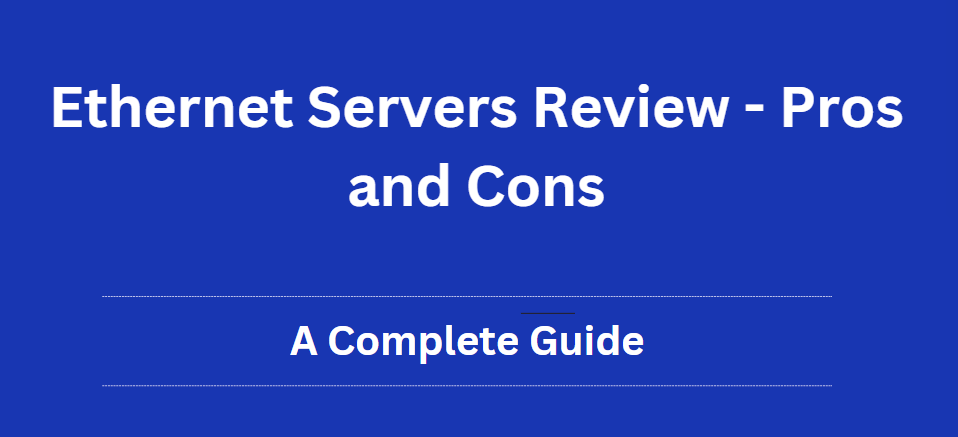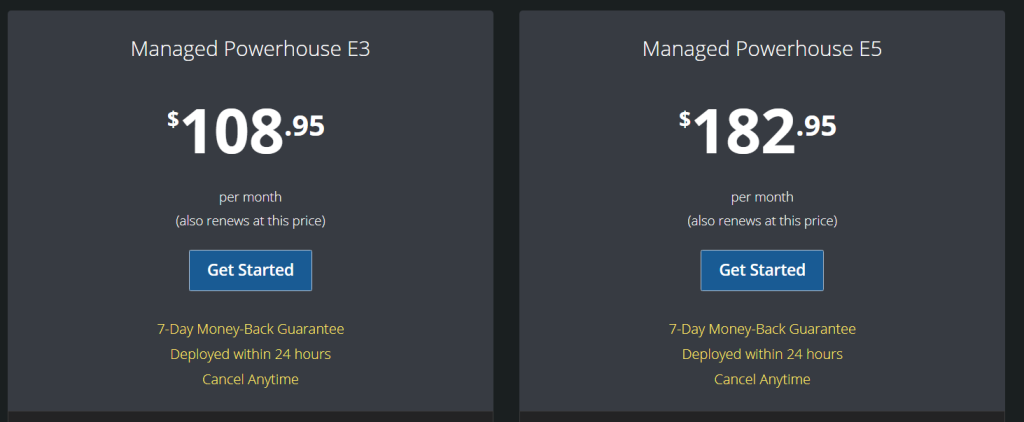In today’s interconnected world of digital communication and data management, Ethernet servers serve as the linchpin of modern IT infrastructures. These servers, powered by Ethernet technology, play a pivotal role in facilitating efficient network operations and seamless data exchange within organizations. From enabling resource sharing and centralized management to supporting critical applications and ensuring data security, Ethernet servers are indispensable in meeting the dynamic demands of businesses and institutions alike.
In this article, you will learn about the essential features, advantages, and considerations associated with Ethernet servers.

What are Ethernet servers?
Ethernet servers, often referred to simply as servers in the context of computer networking, are fundamental components in modern IT infrastructures. They play a crucial role in facilitating communication and data exchange within networks, enabling various services and applications to operate efficiently. This article explores the features, pros, and cons of Ethernet servers, providing a comprehensive overview of their significance in contemporary computing environments.
Features of Ethernet Servers
Below are some features of Ethernet servers
- Network Connectivity: Ethernet servers are designed to connect multiple devices within a local area network (LAN) or extended LAN environment. They use Ethernet technology, which is a widely adopted standard for networking due to its reliability and cost-effectiveness.
- Resource Sharing: Servers allow resources such as files, printers, and applications to be shared among multiple users or client devices. This centralized approach improves efficiency by reducing redundancy and optimizing resource utilization.
- Data Storage and Management: Many servers include storage capabilities, either through direct-attached storage (DAS), network-attached storage (NAS), or storage area networks (SANs). They provide a secure and scalable environment for storing and managing data.
- Security: Servers often incorporate advanced security features such as firewalls, encryption, and access control mechanisms. These measures help protect sensitive data and prevent unauthorized access to the network resources.
- Application Hosting: Servers can host various applications and services, including web hosting, email services, databases, virtualization platforms, and more. This capability enables organizations to centralize their IT operations and streamline maintenance.
- Scalability: Ethernet servers are scalable, allowing organizations to expand their computing capacity and network capabilities as their needs grow. This scalability is crucial for businesses experiencing rapid expansion or fluctuating demand.
- Fault Tolerance and Redundancy: Many servers support features like RAID (Redundant Array of Independent Disks) for data redundancy and fault tolerance. This ensures data availability and minimizes downtime in case of hardware failures.
- Remote Management: Server hardware often includes features for remote management and monitoring. This capability allows IT administrators to perform maintenance tasks, monitor performance metrics, and troubleshoot issues without being physically present at the server location.
Pros of Ethernet Servers
- Centralized Management: Servers enable centralized management of resources, making it easier for IT administrators to deploy updates, enforce security policies, and monitor network activity from a single point.
- Improved Efficiency: By consolidating resources and services onto a server, organizations can achieve higher efficiency in terms of resource utilization, energy consumption, and overall IT management.
- Enhanced Collaboration: Shared resources and centralized data storage facilitate collaboration among users within an organization. This leads to improved productivity and teamwork across different departments or teams.
- Cost-Effectiveness: Despite initial investment costs, Ethernet servers can lead to long-term cost savings by reducing the need for individual devices and simplifying IT infrastructure management.
- Scalability and Flexibility: Servers offer scalability to accommodate changing business needs and technological advancements. They provide flexibility in deploying new applications or scaling resources up or down as required.
- Reliability: Servers are designed with redundancy features and often have higher reliability compared to individual client devices. This reliability contributes to uninterrupted service availability and reduced downtime.
- Security: Centralized security measures on servers help protect data and prevent unauthorized access. This is crucial for compliance with regulatory requirements and safeguarding sensitive information.
Cons of Ethernet Servers
- Initial Cost: Setting up a server infrastructure involves significant upfront costs for hardware, software licenses, and networking equipment. Small businesses or startups may find this initial investment challenging.
- Complexity: Managing servers and configuring them for optimal performance requires specialized knowledge and skills. Complexity increases with the size of the infrastructure and the number of services hosted.
- Single Point of Failure: Despite redundancy measures, servers represent a potential single point of failure for network operations. Hardware failures or software issues can lead to downtime until the problem is resolved.
- Maintenance Overhead: Servers require regular maintenance, updates, and monitoring to ensure optimal performance and security. This ongoing maintenance can be resource-intensive for IT departments.
- Security Risks: Servers, especially those exposed to the internet, are vulnerable to security threats such as hacking attempts, malware, and denial-of-service attacks. Effective security measures and updates are essential to mitigate these risks.
- Scalability Challenges: Scaling server infrastructure can be challenging, especially if not initially planned for. Upgrading hardware, migrating data, and maintaining performance during expansion phases require careful planning.
- Dependency on Network: The performance of Ethernet servers is heavily dependent on network infrastructure. Network bottlenecks or failures can impact server operations and overall productivity.
Price & Cost of Ethernet Servers
Given that they provide comprehensive web hosting solutions, the company offers servers at reasonable pricing. Additionally, they provide deals and discounts of up to 60% off. EthernetServers’ 60-day money-back guarantee is only one of their many wonderful features.
This demonstrates that they are a risk-free business that reimburses clients if they are dissatisfied with their servers. In addition, they provide more services than the typical hosting provider, which offers a 30-day money-back guarantee. Below are some planes of Ethernet Servers.
VPS Plans:

Virtual Private Servers (VPS) provide a middle ground between shared hosting and dedicated servers. They are virtualized environments where multiple VPS instances run on a single physical server, each with its dedicated resources (CPU, RAM, storage).
- Entry-Level VPS: These plans typically start around $10 to $20 per month. They usually include 1-2 CPU cores, 1-2 GB of RAM, and 20-40 GB of SSD storage. Providers may offer discounts for annual billing.
- Mid-Range VPS: These plans range from $20 to $50 per month. They offer more resources, such as 2-4 CPU cores, 4-8 GB of RAM, and 40-100 GB of SSD storage. They are suitable for websites or applications with moderate traffic and resource requirements.
- High-Performance VPS: Plans in this category can cost $50 to $100 or more per month. They typically include 4-8 CPU cores, 8-16 GB of RAM, and 100-200 GB of SSD storage. These plans are ideal for high-traffic websites, e-commerce stores, or resource-intensive applications.
Web Hosting Plans:

Web hosting plans are designed specifically for hosting websites and web applications. They come in various forms, including shared hosting, cloud hosting, and managed WordPress hosting.
- Shared Hosting: Prices start as low as $2 to $10 per month. These plans are economical but may have limitations in terms of performance and resources due to sharing server resources with other users.
- Cloud Hosting: Cloud hosting plans typically range from $5 to $50 per month. They offer scalability, better performance, and redundancy by utilizing resources from multiple servers in a cloud infrastructure.
- Managed WordPress Hosting: Prices generally start around $10 to $30 per month. These plans are optimized for WordPress websites, offering features like automated backups, WordPress updates, and enhanced security.
Dedicated Server Plans:

Dedicated servers provide exclusive use of a physical server dedicated to a single customer. They offer maximum control, performance, and security but come at a higher cost.
- Entry-Level Dedicated Server: Prices start around $80 to $150 per month. These plans usually include a single CPU, 8-16 GB of RAM, and 1-2 TB of HDD storage. They are suitable for small to medium-sized businesses needing dedicated resources.
- Mid-Range Dedicated Server: Costs range from $150 to $300 per month. These plans offer higher CPU performance, 16-32 GB of RAM, and larger storage options (SSD or HDD). They are ideal for websites with moderate to high traffic volumes.
- High-Performance Dedicated Server: Prices can exceed $300 per month or more, depending on the configuration. These plans include multiple CPUs (or high-core CPUs), 32-64 GB+ of RAM, and large SSD storage capacities. They are suitable for enterprise-level applications, large e-commerce sites, or intensive computing tasks.
That’s all for Ethernet servers!
In this article, we have learned about Ethernet servers. Choosing the right hosting plan—whether it’s VPS, web hosting, or dedicated server depends on various factors such as your budget, technical requirements, scalability needs, and level

Leave feedback about this